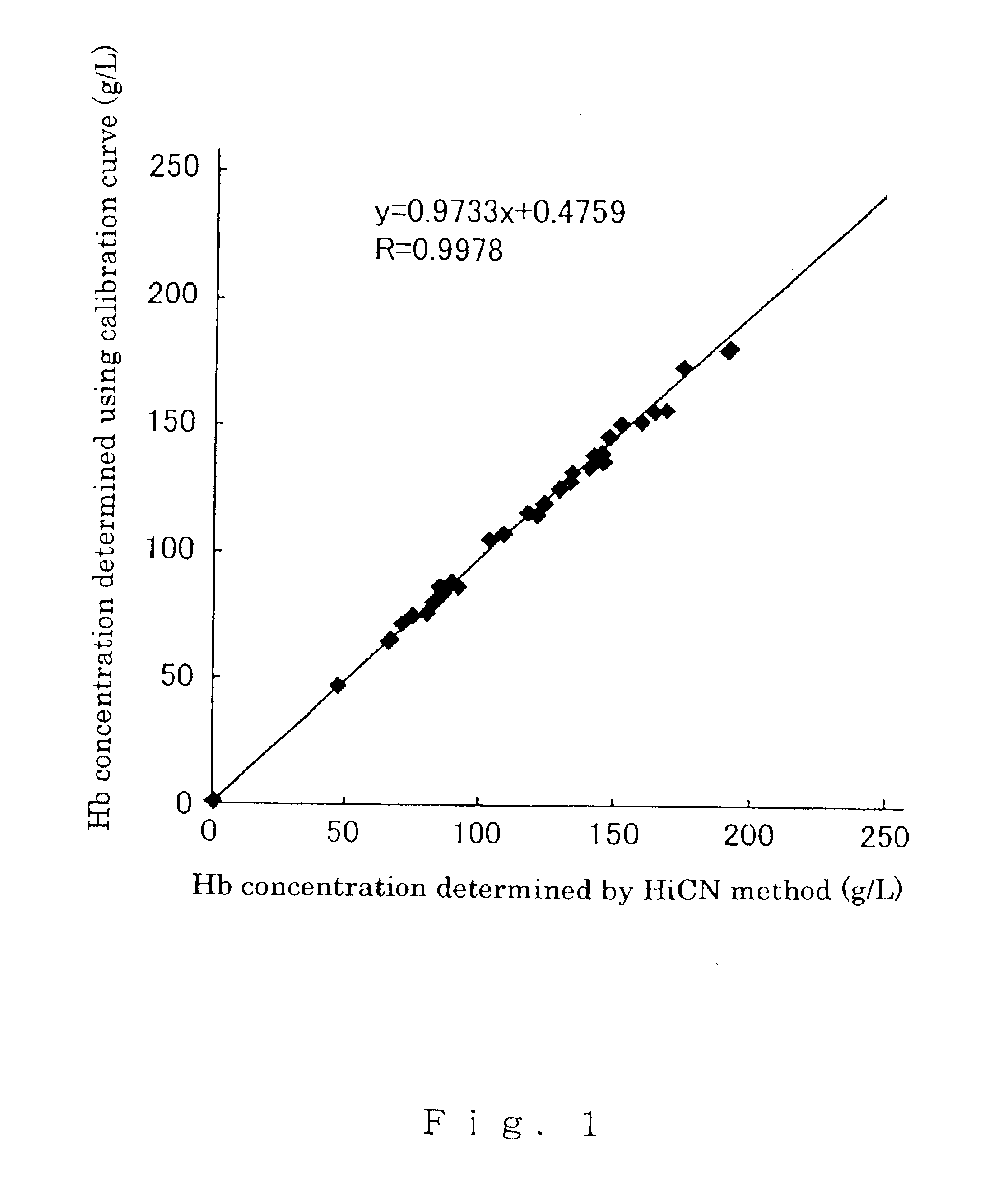Method of quantifying hemoglobin and method of measuring glycation ratio of hemoglobin
a technology of glycation ratio and hemoglobin, which is applied in the direction of color/spectral property measurement, material analysis, instruments, etc., can solve the problems of difficult difficult to carry out the determination of denatured hb in a series of operations, and achieve the effect of improving the accuracy of determination and quick and simple determination of the ratio of glycated hb
- Summary
- Abstract
- Description
- Claims
- Application Information
AI Technical Summary
Benefits of technology
Problems solved by technology
Method used
Image
Examples
example 1
In Example 1, a Hb concentration was determined by denaturing Hb in blood cells with a tetrazolium compound and measuring an absorbance of the denatured Hb, and the correlation between the thus-determined Hb concentration and the Hb concentration determined according to HiCN method as an international standard method was examined. The samples, reagents, and method used in the present example will be described in the following.
Preparation of Samples
Whole blood collected from healthy subjects and diabetic subjects was centrifuged (2000 G, 3 min), and blood cells and plasma were separated and collected from the whole blood. Then, the blood cells and the plasma were mixed with each other at predetermined ratios (blood cells:plasma=10:0, 9:1, 8:2, 7:3, 6:4, 5:5, and 4:6). After that, the mixtures were diluted 15-fold (by volume) with a 0.4 wt % aqueous solution of Triton X-100 (trade name, available from Wako Pure Chemical Industries, hereinafter the same) to prepare 45 samples in total....
example 2
In Example 2, the amount of Hb was determined by the method of determining Hb according to the present invention, and the correlation between the thus-determined amount of Hb and the amount of Hb determined by the SLS method as a control was examined. The samples, reagents, determining method, etc. used in the present example will be described in the following.
Samples
Whole blood collected from healthy subjects and diabetic subjects (71 subjects in total) was centrifuged (1000 G, 10 min), and blood cells fractions were collected. To 10 .mu.L of the respective blood cell fractions was added 40 .mu.L of the hemolysate reagent to prepare hemolysate samples (hereinafter the same).
Determining Method
10 .mu.L of purified water was added to 10 .mu.L of the above-mentioned respective hemolysate samples, and thereafter, 65 .mu.L of the first regent was further added. The resultant mixtures were incubated at 37.degree. C. (the amount of the reaction solutions: 85 .mu.L). Then, 4.5 minutes after...
example 3
In Example 3, HbA1c % was determined by the method of determining a ratio of glycated Hb according to the present invention, and the correlation between the HbA1c % thus determined and the HbA1c % determined according to a control method was examined.
With respect to the above-mentioned hemolysate samples (71 subjects in total), measurement of a first absorbance (measurement wavelength: 571 nm) and measurement of a second absorbance (measurement wavelength: 751 nm) were carried out in the same manner as in Example 2. On the other hand, using a standard solution with known amounts of Hb and HbAlc, a calibration curve (Hb calibration curve) showing the relation between the first absorbance obtained by the method of the present invention and the known amount of Hb, and a calibration curve (HbA1c calibration curve) showing the relationship between the second absorbance obtained by the method of the present invention and the known amount of HbA1c were prepared.
Subsequently, the first abso...
PUM
| Property | Measurement | Unit |
|---|---|---|
| wavelength | aaaaa | aaaaa |
| wavelength | aaaaa | aaaaa |
| wavelength | aaaaa | aaaaa |
Abstract
Description
Claims
Application Information
 Login to View More
Login to View More - R&D
- Intellectual Property
- Life Sciences
- Materials
- Tech Scout
- Unparalleled Data Quality
- Higher Quality Content
- 60% Fewer Hallucinations
Browse by: Latest US Patents, China's latest patents, Technical Efficacy Thesaurus, Application Domain, Technology Topic, Popular Technical Reports.
© 2025 PatSnap. All rights reserved.Legal|Privacy policy|Modern Slavery Act Transparency Statement|Sitemap|About US| Contact US: help@patsnap.com



